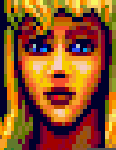Last time, Stoo talked about how Doom is synonymous with the PC consolidating its position as a proper gaming machine. Today, we move a bit further forward into the mid-90s, and a point in time when console games on PC started to become a reality, and the phrase “anything console X can do, the PC can do better!” seemed less like empty my-format-is-best posturing.
The death of the 3DO led to some of its best games arriving on the PC, including Road Rash, FIFA and, best of all, The Need for Speed. TNFS was the racing game I’d always been waiting for, to the extent that I’d asked my parents to consider getting me a 3DO: a racer with real cars, real roads, civilian traffic, and police chases. It was the game Test Drive 2 and Car and Driver could have been if they hadn’t been held back by the technological limitations of their era.
PC gamers were soon furnished with a demo, which allowed you to take the Dodge Viper out on a drive along a single section of coastal road. Even on a 486, which could only handle the visuals in 320×200, it looked great, and repeated plays only served to heighten anticipation for the full game. Aside from trying to drive properly, there seemed to be significant scope for messing around: hitting traffic, pulling handbrake turns, and – best of all – getting up a significant amount of speed and crashing into a roadside barrier, prompting an unrealistic, but spectacular, crash sequence.
Those initial experiences with the demo could almost have been a gaming moment of their own, and the coastal roads did boast some lovely scenery (for the time) including one memorable section where hot air balloons appeared on the horizon, which could have been another contender (banishing memories of Test Drive 2’s windmill-based scenery packs).
However, fun as messing around with the Viper was, it was only natural that the fastest cars would be held back for the full game. The received wisdom of the school playground was that the Lambourghini Diablo had overtaken the Ferrari F40 (which featured in a number of games in the late 80s and early 90s, including Crazy Cars 2, Turbo Outrun and Test Drive 2) as the “fastest and best car ever” and someone had read in their Dad’s car magazine that it could do over 200mph.
The Need for Speed gave you the opportunity to drive a Diablo, and a stretch of road long enough to achieve that top speed. The first section of the city race was pretty much a long straight with little to stop your progress, other than a few pesky slow-moving civilians. While hitting the 200mph mark and beyond was pretty simple, there was also enough of a sense of speed and danger that meant it didn’t feel cheap, either.
In that moment, the promise of so many racing games – that you, a nerdy kid with a computer, could have the keys to any of the world’s top sports cars – had finally been delivered.





 Posts
Posts